Case Study: Managing Exogenous Cushing's Syndrome in Nursing
VerifiedAdded on 2023/04/23
|10
|2522
|429
Case Study
AI Summary
This nursing case study focuses on a 24-year-old patient, Maureen Smith, diagnosed with Exogenous Cushing’s syndrome due to long-term corticosteroid use for rheumatoid arthritis. The study details the disease's causes, risk factors, and impact on the patient and her family, including psychiatric complaints like depression and the strain on family relationships and finances. It discusses common symptoms such as weight gain, hypertension, and type 2 diabetes, explaining the underlying pathophysiology of each. The case study also explores the pharmacodynamics and pharmacokinetics of corticosteroid medications, highlighting their role in inducing Cushing’s syndrome. Finally, it presents a nursing care plan utilizing the ABCDE approach to manage Maureen's symptoms and maintain her insulin and hypertension levels within the required range, emphasizing airway management, breathing assessment, and exposure for thorough examination.
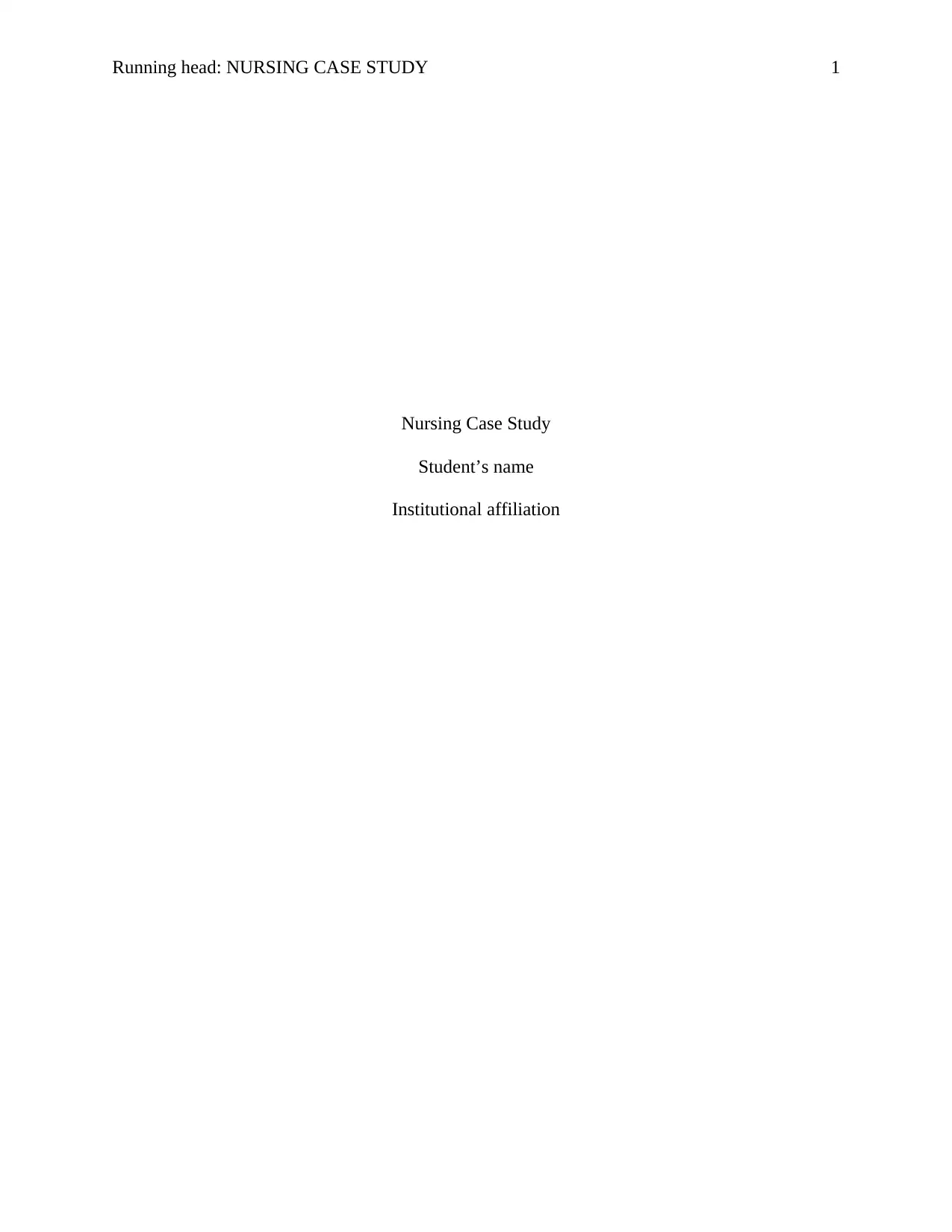
Running head: NURSING CASE STUDY 1
Nursing Case Study
Student’s name
Institutional affiliation
Nursing Case Study
Student’s name
Institutional affiliation
Paraphrase This Document
Need a fresh take? Get an instant paraphrase of this document with our AI Paraphraser
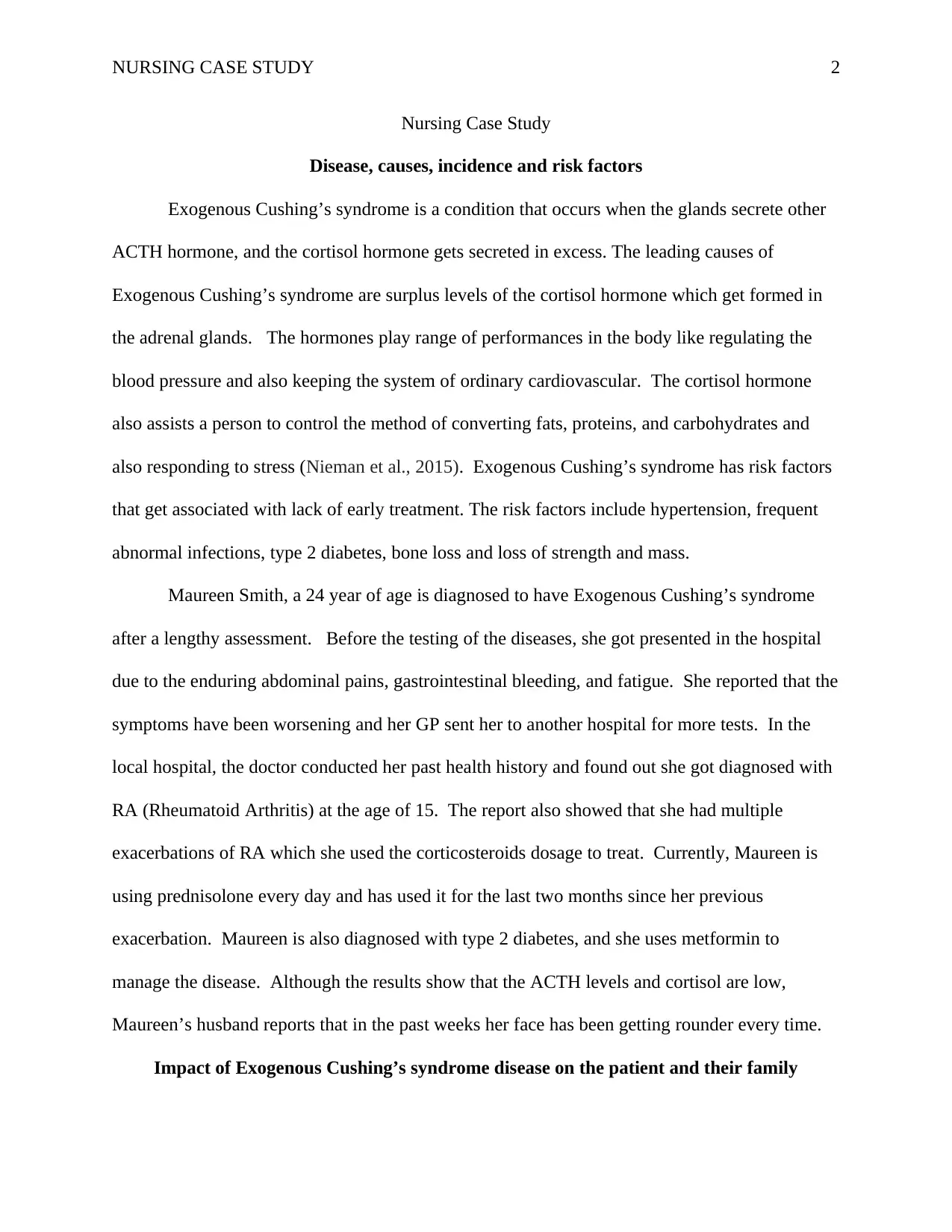
NURSING CASE STUDY 2
Nursing Case Study
Disease, causes, incidence and risk factors
Exogenous Cushing’s syndrome is a condition that occurs when the glands secrete other
ACTH hormone, and the cortisol hormone gets secreted in excess. The leading causes of
Exogenous Cushing’s syndrome are surplus levels of the cortisol hormone which get formed in
the adrenal glands. The hormones play range of performances in the body like regulating the
blood pressure and also keeping the system of ordinary cardiovascular. The cortisol hormone
also assists a person to control the method of converting fats, proteins, and carbohydrates and
also responding to stress (Nieman et al., 2015). Exogenous Cushing’s syndrome has risk factors
that get associated with lack of early treatment. The risk factors include hypertension, frequent
abnormal infections, type 2 diabetes, bone loss and loss of strength and mass.
Maureen Smith, a 24 year of age is diagnosed to have Exogenous Cushing’s syndrome
after a lengthy assessment. Before the testing of the diseases, she got presented in the hospital
due to the enduring abdominal pains, gastrointestinal bleeding, and fatigue. She reported that the
symptoms have been worsening and her GP sent her to another hospital for more tests. In the
local hospital, the doctor conducted her past health history and found out she got diagnosed with
RA (Rheumatoid Arthritis) at the age of 15. The report also showed that she had multiple
exacerbations of RA which she used the corticosteroids dosage to treat. Currently, Maureen is
using prednisolone every day and has used it for the last two months since her previous
exacerbation. Maureen is also diagnosed with type 2 diabetes, and she uses metformin to
manage the disease. Although the results show that the ACTH levels and cortisol are low,
Maureen’s husband reports that in the past weeks her face has been getting rounder every time.
Impact of Exogenous Cushing’s syndrome disease on the patient and their family
Nursing Case Study
Disease, causes, incidence and risk factors
Exogenous Cushing’s syndrome is a condition that occurs when the glands secrete other
ACTH hormone, and the cortisol hormone gets secreted in excess. The leading causes of
Exogenous Cushing’s syndrome are surplus levels of the cortisol hormone which get formed in
the adrenal glands. The hormones play range of performances in the body like regulating the
blood pressure and also keeping the system of ordinary cardiovascular. The cortisol hormone
also assists a person to control the method of converting fats, proteins, and carbohydrates and
also responding to stress (Nieman et al., 2015). Exogenous Cushing’s syndrome has risk factors
that get associated with lack of early treatment. The risk factors include hypertension, frequent
abnormal infections, type 2 diabetes, bone loss and loss of strength and mass.
Maureen Smith, a 24 year of age is diagnosed to have Exogenous Cushing’s syndrome
after a lengthy assessment. Before the testing of the diseases, she got presented in the hospital
due to the enduring abdominal pains, gastrointestinal bleeding, and fatigue. She reported that the
symptoms have been worsening and her GP sent her to another hospital for more tests. In the
local hospital, the doctor conducted her past health history and found out she got diagnosed with
RA (Rheumatoid Arthritis) at the age of 15. The report also showed that she had multiple
exacerbations of RA which she used the corticosteroids dosage to treat. Currently, Maureen is
using prednisolone every day and has used it for the last two months since her previous
exacerbation. Maureen is also diagnosed with type 2 diabetes, and she uses metformin to
manage the disease. Although the results show that the ACTH levels and cortisol are low,
Maureen’s husband reports that in the past weeks her face has been getting rounder every time.
Impact of Exogenous Cushing’s syndrome disease on the patient and their family
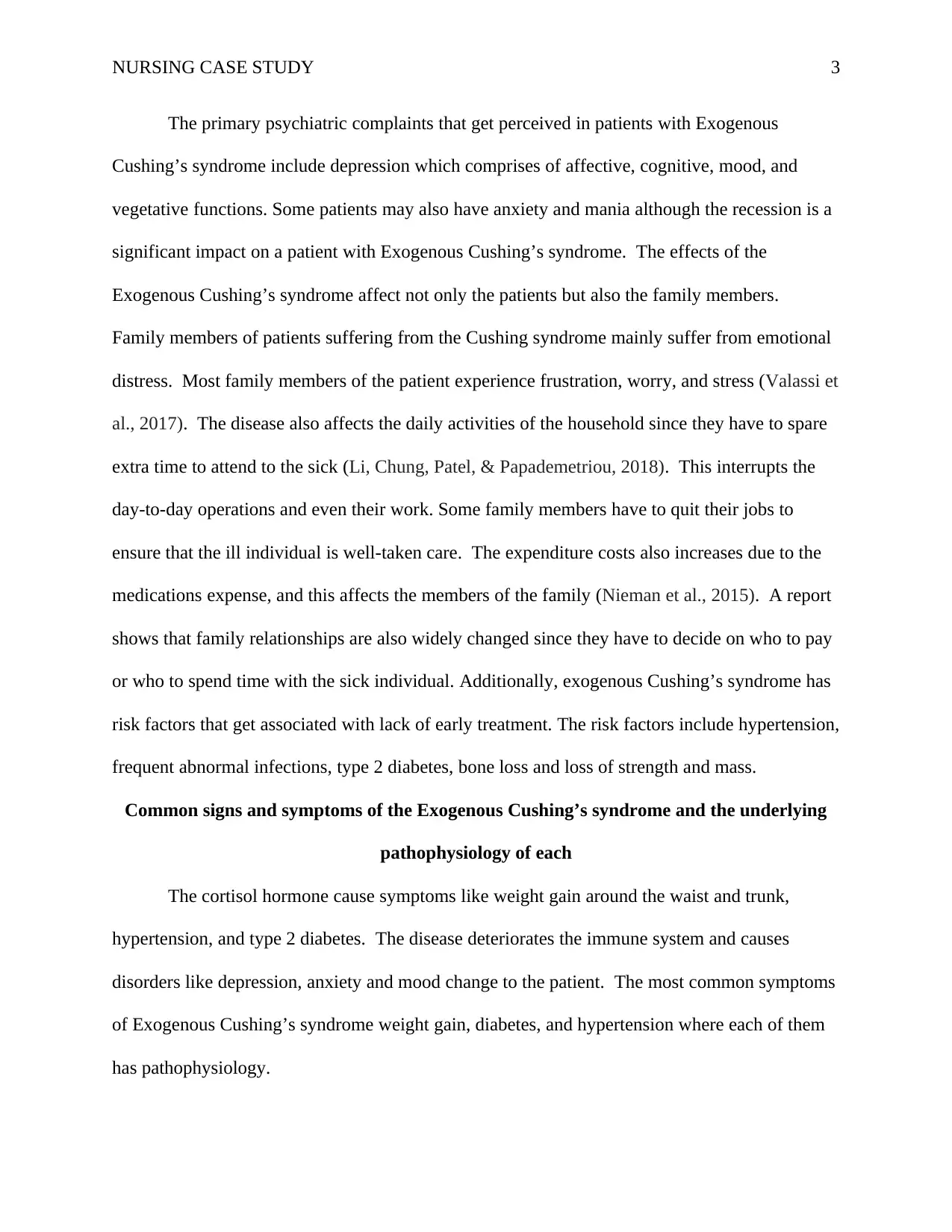
NURSING CASE STUDY 3
The primary psychiatric complaints that get perceived in patients with Exogenous
Cushing’s syndrome include depression which comprises of affective, cognitive, mood, and
vegetative functions. Some patients may also have anxiety and mania although the recession is a
significant impact on a patient with Exogenous Cushing’s syndrome. The effects of the
Exogenous Cushing’s syndrome affect not only the patients but also the family members.
Family members of patients suffering from the Cushing syndrome mainly suffer from emotional
distress. Most family members of the patient experience frustration, worry, and stress (Valassi et
al., 2017). The disease also affects the daily activities of the household since they have to spare
extra time to attend to the sick (Li, Chung, Patel, & Papademetriou, 2018). This interrupts the
day-to-day operations and even their work. Some family members have to quit their jobs to
ensure that the ill individual is well-taken care. The expenditure costs also increases due to the
medications expense, and this affects the members of the family (Nieman et al., 2015). A report
shows that family relationships are also widely changed since they have to decide on who to pay
or who to spend time with the sick individual. Additionally, exogenous Cushing’s syndrome has
risk factors that get associated with lack of early treatment. The risk factors include hypertension,
frequent abnormal infections, type 2 diabetes, bone loss and loss of strength and mass.
Common signs and symptoms of the Exogenous Cushing’s syndrome and the underlying
pathophysiology of each
The cortisol hormone cause symptoms like weight gain around the waist and trunk,
hypertension, and type 2 diabetes. The disease deteriorates the immune system and causes
disorders like depression, anxiety and mood change to the patient. The most common symptoms
of Exogenous Cushing’s syndrome weight gain, diabetes, and hypertension where each of them
has pathophysiology.
The primary psychiatric complaints that get perceived in patients with Exogenous
Cushing’s syndrome include depression which comprises of affective, cognitive, mood, and
vegetative functions. Some patients may also have anxiety and mania although the recession is a
significant impact on a patient with Exogenous Cushing’s syndrome. The effects of the
Exogenous Cushing’s syndrome affect not only the patients but also the family members.
Family members of patients suffering from the Cushing syndrome mainly suffer from emotional
distress. Most family members of the patient experience frustration, worry, and stress (Valassi et
al., 2017). The disease also affects the daily activities of the household since they have to spare
extra time to attend to the sick (Li, Chung, Patel, & Papademetriou, 2018). This interrupts the
day-to-day operations and even their work. Some family members have to quit their jobs to
ensure that the ill individual is well-taken care. The expenditure costs also increases due to the
medications expense, and this affects the members of the family (Nieman et al., 2015). A report
shows that family relationships are also widely changed since they have to decide on who to pay
or who to spend time with the sick individual. Additionally, exogenous Cushing’s syndrome has
risk factors that get associated with lack of early treatment. The risk factors include hypertension,
frequent abnormal infections, type 2 diabetes, bone loss and loss of strength and mass.
Common signs and symptoms of the Exogenous Cushing’s syndrome and the underlying
pathophysiology of each
The cortisol hormone cause symptoms like weight gain around the waist and trunk,
hypertension, and type 2 diabetes. The disease deteriorates the immune system and causes
disorders like depression, anxiety and mood change to the patient. The most common symptoms
of Exogenous Cushing’s syndrome weight gain, diabetes, and hypertension where each of them
has pathophysiology.
⊘ This is a preview!⊘
Do you want full access?
Subscribe today to unlock all pages.

Trusted by 1+ million students worldwide
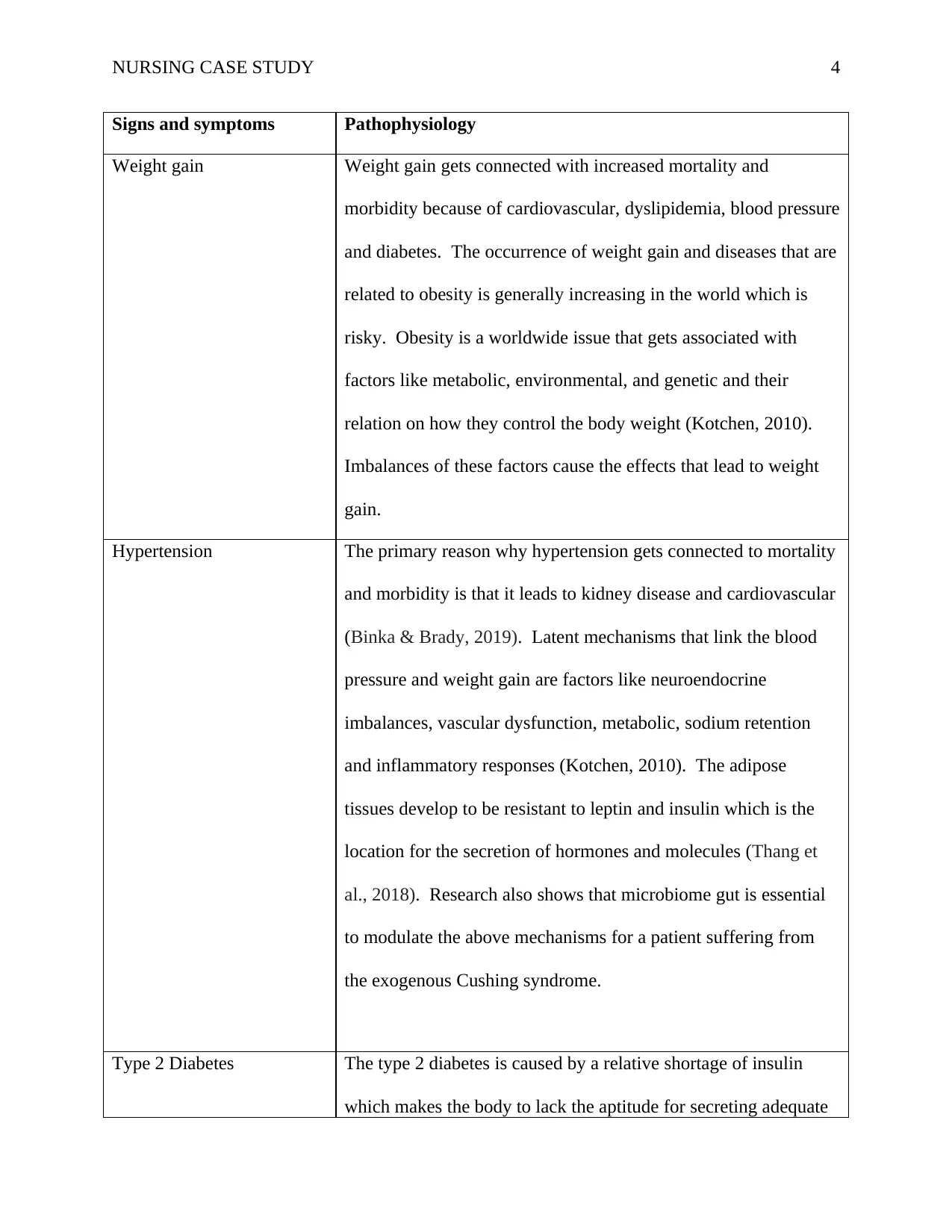
NURSING CASE STUDY 4
Signs and symptoms Pathophysiology
Weight gain Weight gain gets connected with increased mortality and
morbidity because of cardiovascular, dyslipidemia, blood pressure
and diabetes. The occurrence of weight gain and diseases that are
related to obesity is generally increasing in the world which is
risky. Obesity is a worldwide issue that gets associated with
factors like metabolic, environmental, and genetic and their
relation on how they control the body weight (Kotchen, 2010).
Imbalances of these factors cause the effects that lead to weight
gain.
Hypertension The primary reason why hypertension gets connected to mortality
and morbidity is that it leads to kidney disease and cardiovascular
(Binka & Brady, 2019). Latent mechanisms that link the blood
pressure and weight gain are factors like neuroendocrine
imbalances, vascular dysfunction, metabolic, sodium retention
and inflammatory responses (Kotchen, 2010). The adipose
tissues develop to be resistant to leptin and insulin which is the
location for the secretion of hormones and molecules (Thang et
al., 2018). Research also shows that microbiome gut is essential
to modulate the above mechanisms for a patient suffering from
the exogenous Cushing syndrome.
Type 2 Diabetes The type 2 diabetes is caused by a relative shortage of insulin
which makes the body to lack the aptitude for secreting adequate
Signs and symptoms Pathophysiology
Weight gain Weight gain gets connected with increased mortality and
morbidity because of cardiovascular, dyslipidemia, blood pressure
and diabetes. The occurrence of weight gain and diseases that are
related to obesity is generally increasing in the world which is
risky. Obesity is a worldwide issue that gets associated with
factors like metabolic, environmental, and genetic and their
relation on how they control the body weight (Kotchen, 2010).
Imbalances of these factors cause the effects that lead to weight
gain.
Hypertension The primary reason why hypertension gets connected to mortality
and morbidity is that it leads to kidney disease and cardiovascular
(Binka & Brady, 2019). Latent mechanisms that link the blood
pressure and weight gain are factors like neuroendocrine
imbalances, vascular dysfunction, metabolic, sodium retention
and inflammatory responses (Kotchen, 2010). The adipose
tissues develop to be resistant to leptin and insulin which is the
location for the secretion of hormones and molecules (Thang et
al., 2018). Research also shows that microbiome gut is essential
to modulate the above mechanisms for a patient suffering from
the exogenous Cushing syndrome.
Type 2 Diabetes The type 2 diabetes is caused by a relative shortage of insulin
which makes the body to lack the aptitude for secreting adequate
Paraphrase This Document
Need a fresh take? Get an instant paraphrase of this document with our AI Paraphraser
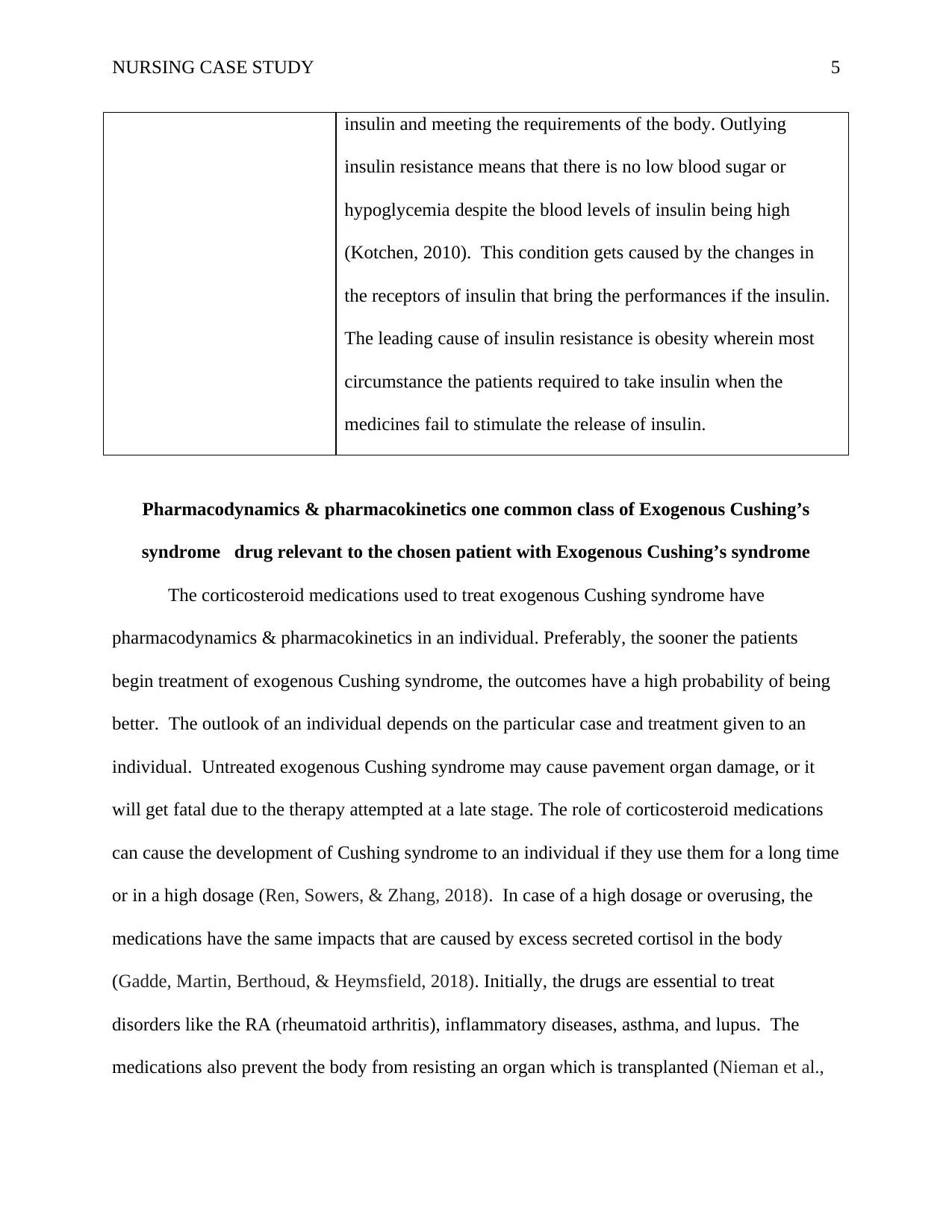
NURSING CASE STUDY 5
insulin and meeting the requirements of the body. Outlying
insulin resistance means that there is no low blood sugar or
hypoglycemia despite the blood levels of insulin being high
(Kotchen, 2010). This condition gets caused by the changes in
the receptors of insulin that bring the performances if the insulin.
The leading cause of insulin resistance is obesity wherein most
circumstance the patients required to take insulin when the
medicines fail to stimulate the release of insulin.
Pharmacodynamics & pharmacokinetics one common class of Exogenous Cushing’s
syndrome drug relevant to the chosen patient with Exogenous Cushing’s syndrome
The corticosteroid medications used to treat exogenous Cushing syndrome have
pharmacodynamics & pharmacokinetics in an individual. Preferably, the sooner the patients
begin treatment of exogenous Cushing syndrome, the outcomes have a high probability of being
better. The outlook of an individual depends on the particular case and treatment given to an
individual. Untreated exogenous Cushing syndrome may cause pavement organ damage, or it
will get fatal due to the therapy attempted at a late stage. The role of corticosteroid medications
can cause the development of Cushing syndrome to an individual if they use them for a long time
or in a high dosage (Ren, Sowers, & Zhang, 2018). In case of a high dosage or overusing, the
medications have the same impacts that are caused by excess secreted cortisol in the body
(Gadde, Martin, Berthoud, & Heymsfield, 2018). Initially, the drugs are essential to treat
disorders like the RA (rheumatoid arthritis), inflammatory diseases, asthma, and lupus. The
medications also prevent the body from resisting an organ which is transplanted (Nieman et al.,
insulin and meeting the requirements of the body. Outlying
insulin resistance means that there is no low blood sugar or
hypoglycemia despite the blood levels of insulin being high
(Kotchen, 2010). This condition gets caused by the changes in
the receptors of insulin that bring the performances if the insulin.
The leading cause of insulin resistance is obesity wherein most
circumstance the patients required to take insulin when the
medicines fail to stimulate the release of insulin.
Pharmacodynamics & pharmacokinetics one common class of Exogenous Cushing’s
syndrome drug relevant to the chosen patient with Exogenous Cushing’s syndrome
The corticosteroid medications used to treat exogenous Cushing syndrome have
pharmacodynamics & pharmacokinetics in an individual. Preferably, the sooner the patients
begin treatment of exogenous Cushing syndrome, the outcomes have a high probability of being
better. The outlook of an individual depends on the particular case and treatment given to an
individual. Untreated exogenous Cushing syndrome may cause pavement organ damage, or it
will get fatal due to the therapy attempted at a late stage. The role of corticosteroid medications
can cause the development of Cushing syndrome to an individual if they use them for a long time
or in a high dosage (Ren, Sowers, & Zhang, 2018). In case of a high dosage or overusing, the
medications have the same impacts that are caused by excess secreted cortisol in the body
(Gadde, Martin, Berthoud, & Heymsfield, 2018). Initially, the drugs are essential to treat
disorders like the RA (rheumatoid arthritis), inflammatory diseases, asthma, and lupus. The
medications also prevent the body from resisting an organ which is transplanted (Nieman et al.,
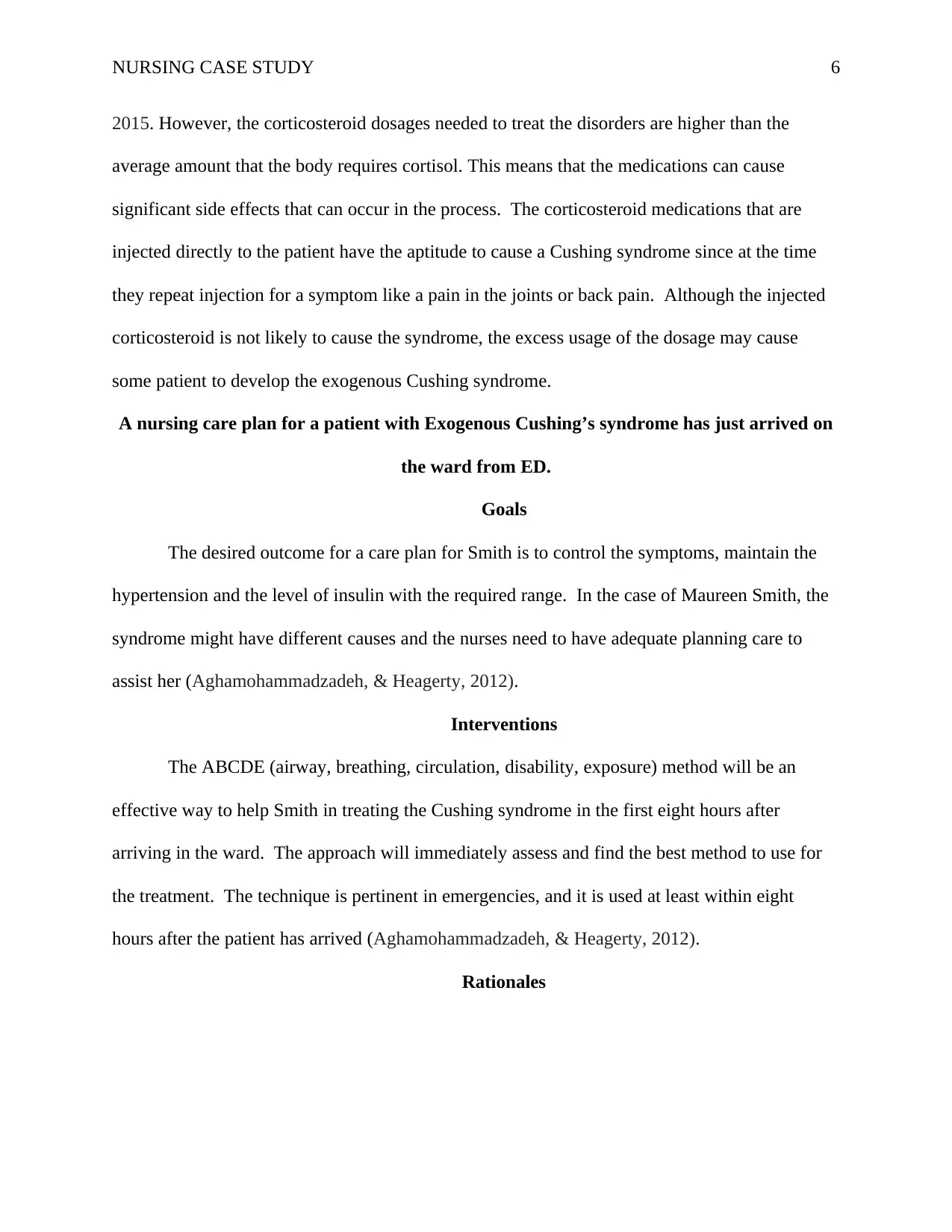
NURSING CASE STUDY 6
2015. However, the corticosteroid dosages needed to treat the disorders are higher than the
average amount that the body requires cortisol. This means that the medications can cause
significant side effects that can occur in the process. The corticosteroid medications that are
injected directly to the patient have the aptitude to cause a Cushing syndrome since at the time
they repeat injection for a symptom like a pain in the joints or back pain. Although the injected
corticosteroid is not likely to cause the syndrome, the excess usage of the dosage may cause
some patient to develop the exogenous Cushing syndrome.
A nursing care plan for a patient with Exogenous Cushing’s syndrome has just arrived on
the ward from ED.
Goals
The desired outcome for a care plan for Smith is to control the symptoms, maintain the
hypertension and the level of insulin with the required range. In the case of Maureen Smith, the
syndrome might have different causes and the nurses need to have adequate planning care to
assist her (Aghamohammadzadeh, & Heagerty, 2012).
Interventions
The ABCDE (airway, breathing, circulation, disability, exposure) method will be an
effective way to help Smith in treating the Cushing syndrome in the first eight hours after
arriving in the ward. The approach will immediately assess and find the best method to use for
the treatment. The technique is pertinent in emergencies, and it is used at least within eight
hours after the patient has arrived (Aghamohammadzadeh, & Heagerty, 2012).
Rationales
2015. However, the corticosteroid dosages needed to treat the disorders are higher than the
average amount that the body requires cortisol. This means that the medications can cause
significant side effects that can occur in the process. The corticosteroid medications that are
injected directly to the patient have the aptitude to cause a Cushing syndrome since at the time
they repeat injection for a symptom like a pain in the joints or back pain. Although the injected
corticosteroid is not likely to cause the syndrome, the excess usage of the dosage may cause
some patient to develop the exogenous Cushing syndrome.
A nursing care plan for a patient with Exogenous Cushing’s syndrome has just arrived on
the ward from ED.
Goals
The desired outcome for a care plan for Smith is to control the symptoms, maintain the
hypertension and the level of insulin with the required range. In the case of Maureen Smith, the
syndrome might have different causes and the nurses need to have adequate planning care to
assist her (Aghamohammadzadeh, & Heagerty, 2012).
Interventions
The ABCDE (airway, breathing, circulation, disability, exposure) method will be an
effective way to help Smith in treating the Cushing syndrome in the first eight hours after
arriving in the ward. The approach will immediately assess and find the best method to use for
the treatment. The technique is pertinent in emergencies, and it is used at least within eight
hours after the patient has arrived (Aghamohammadzadeh, & Heagerty, 2012).
Rationales
⊘ This is a preview!⊘
Do you want full access?
Subscribe today to unlock all pages.

Trusted by 1+ million students worldwide
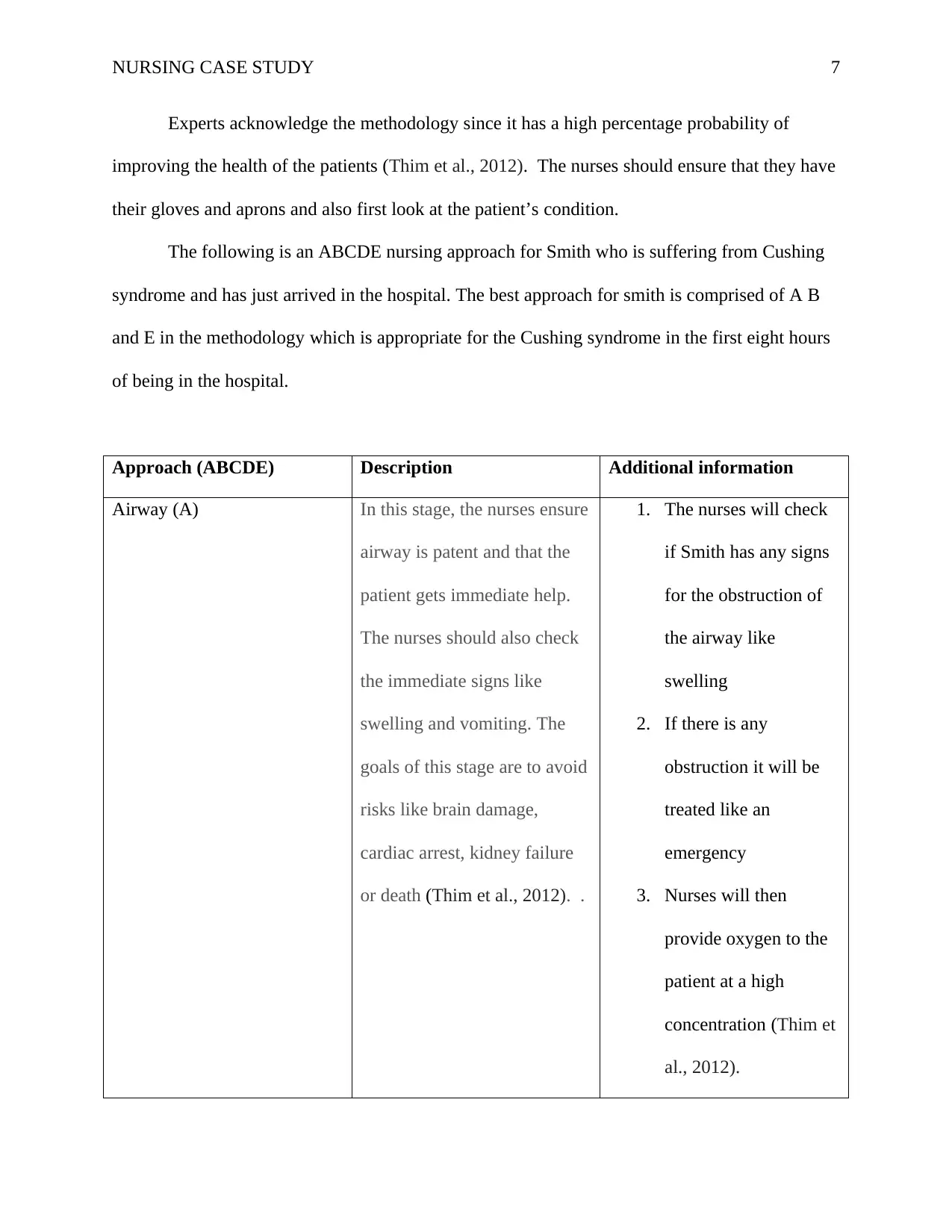
NURSING CASE STUDY 7
Experts acknowledge the methodology since it has a high percentage probability of
improving the health of the patients (Thim et al., 2012). The nurses should ensure that they have
their gloves and aprons and also first look at the patient’s condition.
The following is an ABCDE nursing approach for Smith who is suffering from Cushing
syndrome and has just arrived in the hospital. The best approach for smith is comprised of A B
and E in the methodology which is appropriate for the Cushing syndrome in the first eight hours
of being in the hospital.
Approach (ABCDE) Description Additional information
Airway (A) In this stage, the nurses ensure
airway is patent and that the
patient gets immediate help.
The nurses should also check
the immediate signs like
swelling and vomiting. The
goals of this stage are to avoid
risks like brain damage,
cardiac arrest, kidney failure
or death (Thim et al., 2012). .
1. The nurses will check
if Smith has any signs
for the obstruction of
the airway like
swelling
2. If there is any
obstruction it will be
treated like an
emergency
3. Nurses will then
provide oxygen to the
patient at a high
concentration (Thim et
al., 2012).
Experts acknowledge the methodology since it has a high percentage probability of
improving the health of the patients (Thim et al., 2012). The nurses should ensure that they have
their gloves and aprons and also first look at the patient’s condition.
The following is an ABCDE nursing approach for Smith who is suffering from Cushing
syndrome and has just arrived in the hospital. The best approach for smith is comprised of A B
and E in the methodology which is appropriate for the Cushing syndrome in the first eight hours
of being in the hospital.
Approach (ABCDE) Description Additional information
Airway (A) In this stage, the nurses ensure
airway is patent and that the
patient gets immediate help.
The nurses should also check
the immediate signs like
swelling and vomiting. The
goals of this stage are to avoid
risks like brain damage,
cardiac arrest, kidney failure
or death (Thim et al., 2012). .
1. The nurses will check
if Smith has any signs
for the obstruction of
the airway like
swelling
2. If there is any
obstruction it will be
treated like an
emergency
3. Nurses will then
provide oxygen to the
patient at a high
concentration (Thim et
al., 2012).
Paraphrase This Document
Need a fresh take? Get an instant paraphrase of this document with our AI Paraphraser
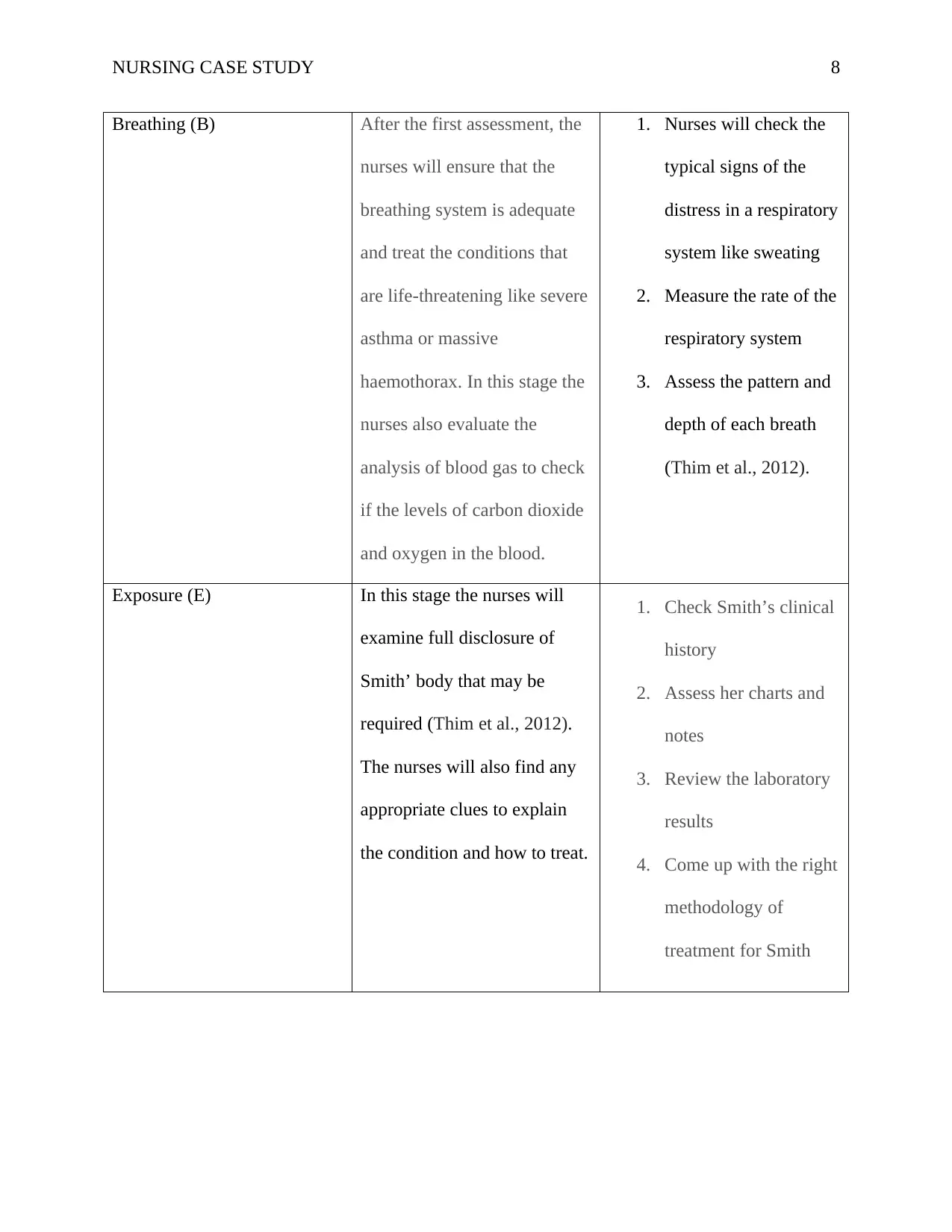
NURSING CASE STUDY 8
Breathing (B) After the first assessment, the
nurses will ensure that the
breathing system is adequate
and treat the conditions that
are life-threatening like severe
asthma or massive
haemothorax. In this stage the
nurses also evaluate the
analysis of blood gas to check
if the levels of carbon dioxide
and oxygen in the blood.
1. Nurses will check the
typical signs of the
distress in a respiratory
system like sweating
2. Measure the rate of the
respiratory system
3. Assess the pattern and
depth of each breath
(Thim et al., 2012).
Exposure (E) In this stage the nurses will
examine full disclosure of
Smith’ body that may be
required (Thim et al., 2012).
The nurses will also find any
appropriate clues to explain
the condition and how to treat.
1. Check Smith’s clinical
history
2. Assess her charts and
notes
3. Review the laboratory
results
4. Come up with the right
methodology of
treatment for Smith
Breathing (B) After the first assessment, the
nurses will ensure that the
breathing system is adequate
and treat the conditions that
are life-threatening like severe
asthma or massive
haemothorax. In this stage the
nurses also evaluate the
analysis of blood gas to check
if the levels of carbon dioxide
and oxygen in the blood.
1. Nurses will check the
typical signs of the
distress in a respiratory
system like sweating
2. Measure the rate of the
respiratory system
3. Assess the pattern and
depth of each breath
(Thim et al., 2012).
Exposure (E) In this stage the nurses will
examine full disclosure of
Smith’ body that may be
required (Thim et al., 2012).
The nurses will also find any
appropriate clues to explain
the condition and how to treat.
1. Check Smith’s clinical
history
2. Assess her charts and
notes
3. Review the laboratory
results
4. Come up with the right
methodology of
treatment for Smith
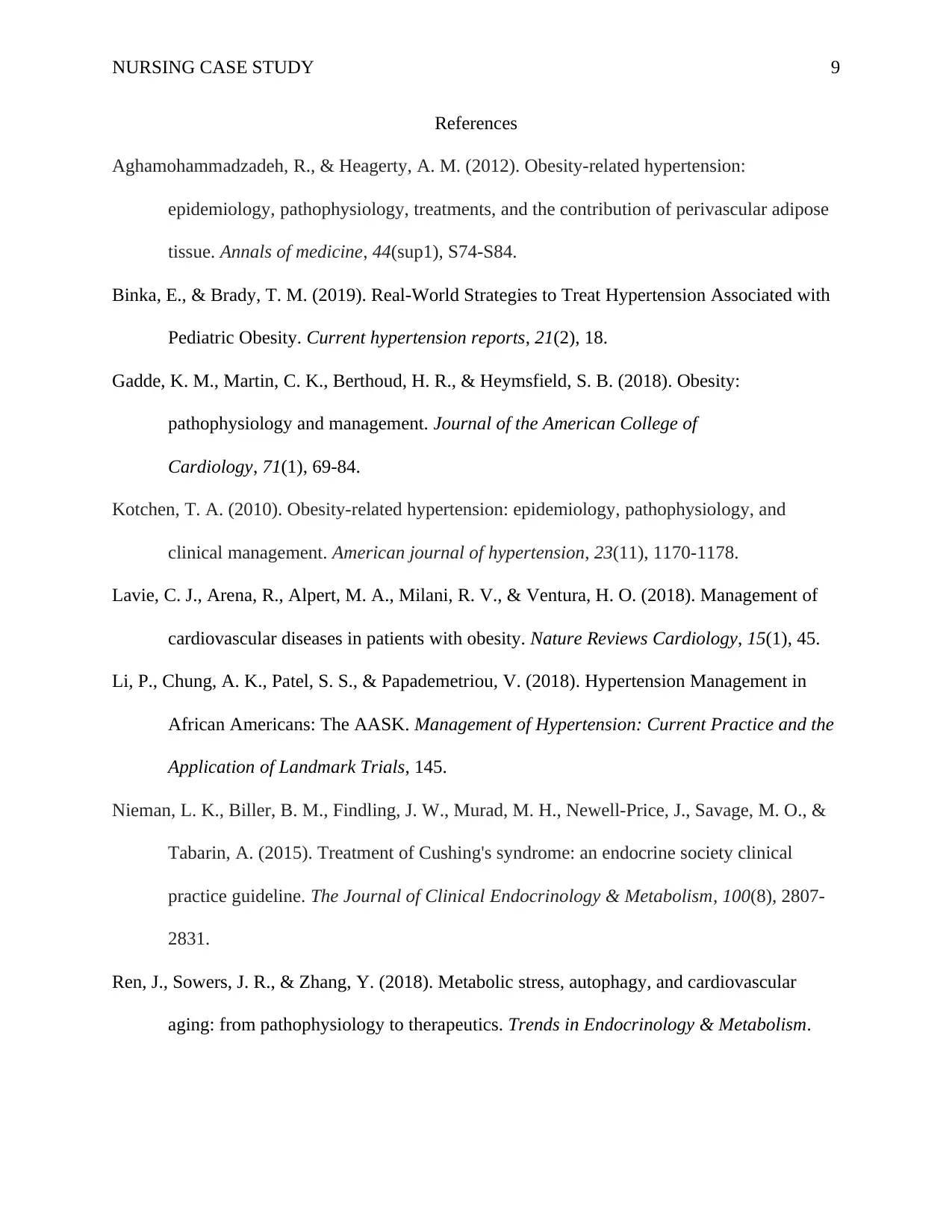
NURSING CASE STUDY 9
References
Aghamohammadzadeh, R., & Heagerty, A. M. (2012). Obesity-related hypertension:
epidemiology, pathophysiology, treatments, and the contribution of perivascular adipose
tissue. Annals of medicine, 44(sup1), S74-S84.
Binka, E., & Brady, T. M. (2019). Real-World Strategies to Treat Hypertension Associated with
Pediatric Obesity. Current hypertension reports, 21(2), 18.
Gadde, K. M., Martin, C. K., Berthoud, H. R., & Heymsfield, S. B. (2018). Obesity:
pathophysiology and management. Journal of the American College of
Cardiology, 71(1), 69-84.
Kotchen, T. A. (2010). Obesity-related hypertension: epidemiology, pathophysiology, and
clinical management. American journal of hypertension, 23(11), 1170-1178.
Lavie, C. J., Arena, R., Alpert, M. A., Milani, R. V., & Ventura, H. O. (2018). Management of
cardiovascular diseases in patients with obesity. Nature Reviews Cardiology, 15(1), 45.
Li, P., Chung, A. K., Patel, S. S., & Papademetriou, V. (2018). Hypertension Management in
African Americans: The AASK. Management of Hypertension: Current Practice and the
Application of Landmark Trials, 145.
Nieman, L. K., Biller, B. M., Findling, J. W., Murad, M. H., Newell-Price, J., Savage, M. O., &
Tabarin, A. (2015). Treatment of Cushing's syndrome: an endocrine society clinical
practice guideline. The Journal of Clinical Endocrinology & Metabolism, 100(8), 2807-
2831.
Ren, J., Sowers, J. R., & Zhang, Y. (2018). Metabolic stress, autophagy, and cardiovascular
aging: from pathophysiology to therapeutics. Trends in Endocrinology & Metabolism.
References
Aghamohammadzadeh, R., & Heagerty, A. M. (2012). Obesity-related hypertension:
epidemiology, pathophysiology, treatments, and the contribution of perivascular adipose
tissue. Annals of medicine, 44(sup1), S74-S84.
Binka, E., & Brady, T. M. (2019). Real-World Strategies to Treat Hypertension Associated with
Pediatric Obesity. Current hypertension reports, 21(2), 18.
Gadde, K. M., Martin, C. K., Berthoud, H. R., & Heymsfield, S. B. (2018). Obesity:
pathophysiology and management. Journal of the American College of
Cardiology, 71(1), 69-84.
Kotchen, T. A. (2010). Obesity-related hypertension: epidemiology, pathophysiology, and
clinical management. American journal of hypertension, 23(11), 1170-1178.
Lavie, C. J., Arena, R., Alpert, M. A., Milani, R. V., & Ventura, H. O. (2018). Management of
cardiovascular diseases in patients with obesity. Nature Reviews Cardiology, 15(1), 45.
Li, P., Chung, A. K., Patel, S. S., & Papademetriou, V. (2018). Hypertension Management in
African Americans: The AASK. Management of Hypertension: Current Practice and the
Application of Landmark Trials, 145.
Nieman, L. K., Biller, B. M., Findling, J. W., Murad, M. H., Newell-Price, J., Savage, M. O., &
Tabarin, A. (2015). Treatment of Cushing's syndrome: an endocrine society clinical
practice guideline. The Journal of Clinical Endocrinology & Metabolism, 100(8), 2807-
2831.
Ren, J., Sowers, J. R., & Zhang, Y. (2018). Metabolic stress, autophagy, and cardiovascular
aging: from pathophysiology to therapeutics. Trends in Endocrinology & Metabolism.
⊘ This is a preview!⊘
Do you want full access?
Subscribe today to unlock all pages.

Trusted by 1+ million students worldwide
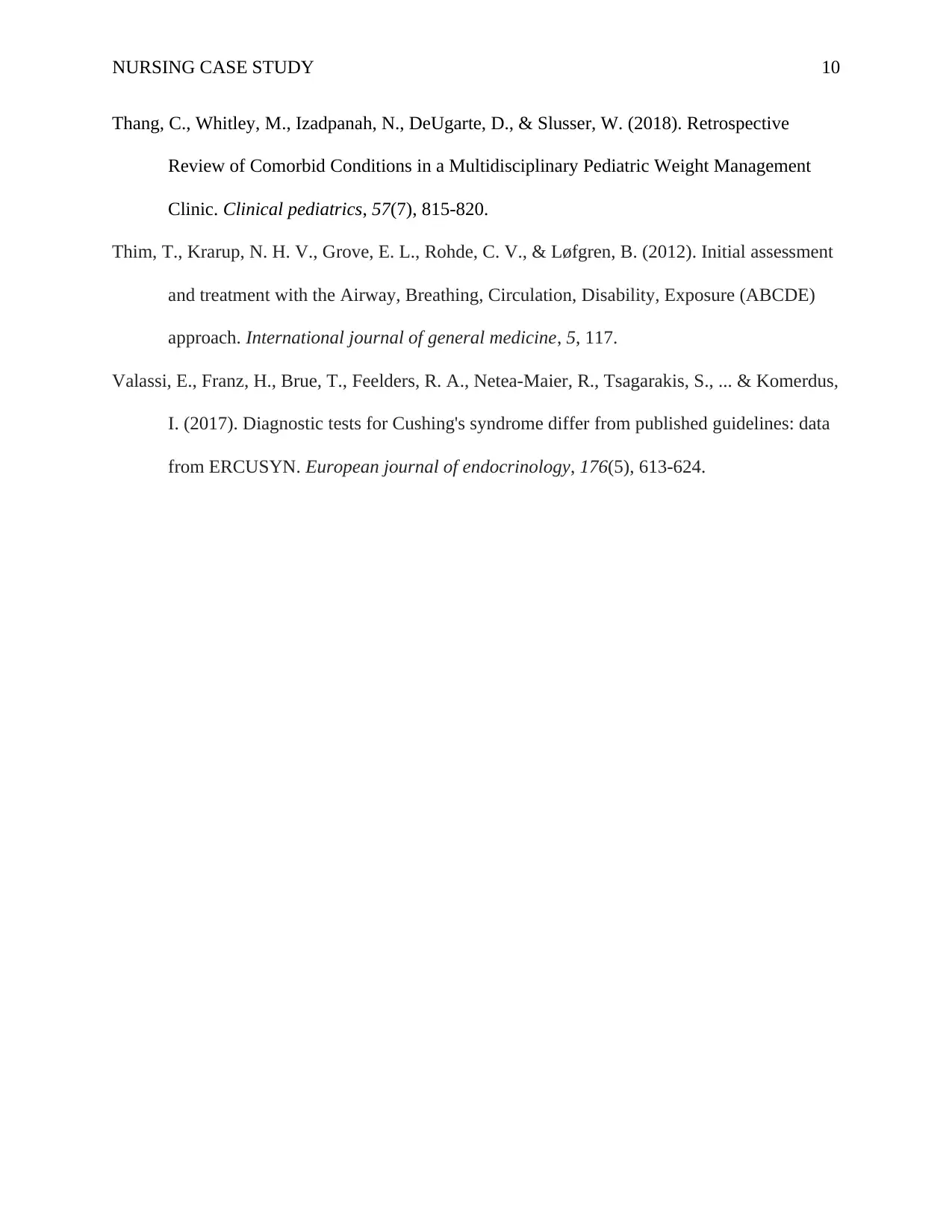
NURSING CASE STUDY 10
Thang, C., Whitley, M., Izadpanah, N., DeUgarte, D., & Slusser, W. (2018). Retrospective
Review of Comorbid Conditions in a Multidisciplinary Pediatric Weight Management
Clinic. Clinical pediatrics, 57(7), 815-820.
Thim, T., Krarup, N. H. V., Grove, E. L., Rohde, C. V., & Løfgren, B. (2012). Initial assessment
and treatment with the Airway, Breathing, Circulation, Disability, Exposure (ABCDE)
approach. International journal of general medicine, 5, 117.
Valassi, E., Franz, H., Brue, T., Feelders, R. A., Netea-Maier, R., Tsagarakis, S., ... & Komerdus,
I. (2017). Diagnostic tests for Cushing's syndrome differ from published guidelines: data
from ERCUSYN. European journal of endocrinology, 176(5), 613-624.
Thang, C., Whitley, M., Izadpanah, N., DeUgarte, D., & Slusser, W. (2018). Retrospective
Review of Comorbid Conditions in a Multidisciplinary Pediatric Weight Management
Clinic. Clinical pediatrics, 57(7), 815-820.
Thim, T., Krarup, N. H. V., Grove, E. L., Rohde, C. V., & Løfgren, B. (2012). Initial assessment
and treatment with the Airway, Breathing, Circulation, Disability, Exposure (ABCDE)
approach. International journal of general medicine, 5, 117.
Valassi, E., Franz, H., Brue, T., Feelders, R. A., Netea-Maier, R., Tsagarakis, S., ... & Komerdus,
I. (2017). Diagnostic tests for Cushing's syndrome differ from published guidelines: data
from ERCUSYN. European journal of endocrinology, 176(5), 613-624.
1 out of 10
Related Documents
Your All-in-One AI-Powered Toolkit for Academic Success.
+13062052269
info@desklib.com
Available 24*7 on WhatsApp / Email
![[object Object]](/_next/static/media/star-bottom.7253800d.svg)
Unlock your academic potential
Copyright © 2020–2025 A2Z Services. All Rights Reserved. Developed and managed by ZUCOL.





